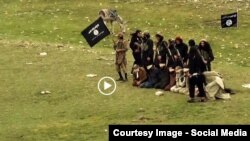By continuing to bomb and abduct civilians and burning their property, the Islamic State (IS) militants are ramping up atrocities in Afghanistan’s eastern Nangarhar Province.
The new spike in IS violence in the remote mountainous districts of Nangarhar, close to Afghanistan’s eastern border with Pakistan, comes after months of claims by Afghan government and international forces that the ultra-radical group is on the run and has been hemorrhaging territory, fighters, and leaders.
On January 15, authorities in Nangarhar said they are trying to secure the release of at least 13 teachers who were abducted from a madrasah in Haska Mina district.
“The Taliban are not active in this district but Daesh (eds: local name for IS) occasionally pulls off such attacks,” Ataullah Khugyani, a spokesman for the Nangarhar governor, told Radio Free Afghanistan. "The teachers were busy with exams at the madrasah when [the Islamic State] militants kidnapped 13 of them and took them to an unknown place."
Also on January 15, at least seven civilians, including a woman and three children, were killed in a roadside bomb in Nangarhar’s Pachir Wa Agam district.
The attack, while not claimed by anyone, happened in a remote region controlled until recently by IS.
Shirin Aqa Faqir, a spokesman for the Afghan Army in Nangarhar, said Pachir Wa Agam was reclaimed from IS last week. "The IS group has been driven out of Pachir Wa Agam, and the area is now free of IS fighters," he told VOA's Afghan service.
A day earlier, IS fighters attacked nearby Kot district. They first targeted local tribal volunteers who have picked up guns to defend their communities and later moved toward an Afghan police check post.
Earlier on January 11, IS fighters burned some 65 civilian houses in Kot’s Baba Ghondai and Bar Sepai villages.
Haji Amir Jan Kotwal, a local tribal leader, said houses were burned after local civilians refused to return to live under IS.
“Daesh has declared enemies of anyone who refuses to live under their authority or resists joining them to fight for them,” he told Radio Free Afghanistan. “Daesh did this to retaliate against the announcement of a government offensive [in Kot] that was backed by locals.”
Residents of Kot and nine more districts in Nangarhar have endured horrific atrocities at the hands of IS fighters, who first emerged in the region in early 2015. By that summer, they virtually controlled nine Nangarhar districts including Kot, Pachir Wa Agam and Haska Mina.
Their atrocities against civilians were showcased in an August 2015 IS video that depicted bound and blindfolded Afghan laborers forced to sit on explosives.
Even the Taliban joined Afghan government and political leaders in condemning the atrocity.
Yet the group is regularly blamed for consistent extreme violence against civilians, which prompted thousands of civilian families to flee their home in the Nangarhar district IS overran.
By the fall of 2015, IS atrocities had provoked an uprising among Nangarhar’s Pashtun Shinwari tribe and compelled Kabul and the U.S.-led international forces to act.
Last year, General John Nicholson, the top U.S. commander in Afghanistan, said Afghan and international troops have reduced IS sanctuaries to three districts from nine.
He told reporters in September that Hafiz Saeed Khan, the leader of IS Khorasan Wilyat, the group’s name for its Afghanistan-Pakistan branch, was killed in the summer. Nicholson said 11 other top leaders and 25 percent of IS fighters were also killed.
“We estimate their numbers are 1,200 or 1,300 fighters. They have some enclaves in [neighboring] Kunar Province, but primarily they are in Nangarhar Province,” he told reporters.
The increasing number of IS attacks in Nangarhar, however, showcase the group’s resilience.
With reporting by the Voice Of America








